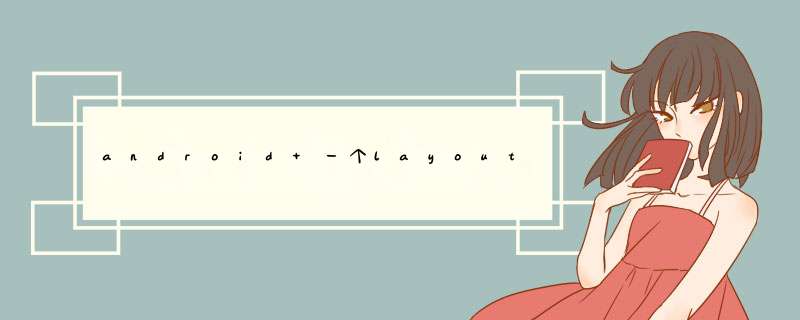
一个layout就是一个容器,你可以放一些子控件,当你要 *** 作子控件的时候,你就需要找对应的子控件,再去 *** 作它( *** 作比如设置字体,颜色,样式等)。
可以通过findViewById()方法 来获取,前提是,你的子控件需要定义一个id,然后在通过该方法来寻找并 *** 作它。
还可以通过findViewWithTag()方法来找到子控件(前提是你第一次找到这个子控件时,并设置一个tag),该方法一般用在activity调用adapter里面填充布局里面的子控件。
自定义view-------onLayout
view类的onLayout()是个空方法
viewGroup的onLayout()是个抽象方法
layou()中的onLayout() 是用来设置viewgroup中子view的位置的 ,而不是用来设置当前view的位置的
/ 存储所有的View,按行记录 /
private List> mAllViews = new ArrayList>()
/ 记录每一行的最大高度 /
private ListmLineHeight = new ArrayList();
@Override
protected void onLayout(boolean changed, int l, int t, int r, int b)
{
mAllViewsclear();
mLineHeightclear();
int width = getWidth();
int lineWidth = 0; // 记录每一行 每加入一个子view之后的当前行宽
int lineHeight = 0 ; // 记录每一行 每加入一个子view之后的当前行高(取最大值)
ListlineViews = new ArrayList();
int cCount = getChildCount();
// 遍历所有的孩子
for (int i = 0; i < cCount; i++) {
View child = getChildAt(i);
MarginLayoutParams lp = (MarginLayoutParams) childgetLayoutParams();
int childWidth = childgetMeasuredWidth();
int childHeight = childgetMeasuredHeight();
// 如果已经需要换行
if (childWidth + lpleftMargin + lprightMargin + lineWidth > width) {
// 记录这一行所有的View以及最大高度
mLineHeightadd(lineHeight);
// 将当前行的childView保存,然后开启新的ArrayList保存下一行的childView mAllViewsadd(lineViews);
lineWidth = 0;// 重置行宽
lineViews = new ArrayList();
}
/
如果不需要换行,则累加
/
lineWidth += childWidth + lpleftMargin + lprightMargin;
lineHeight = Mathmax(lineHeight, childHeight + lptopMargin+ lpbottomMargin);
lineViewsadd(child);
}
// 记录最后一行
mLineHeightadd(lineHeight);
mAllViewsadd(lineViews);
此循环小结
// 获取到所有的子view 以及子view的Marginlayoutparams
// 根据当前子view的宽度左右margin 以及当前行的lineWindth 判断是否换行
// 如果换行 则 将行高加入保存下来 并重置行宽行高以及行集合
// 并将行集合保存到总集合之中
// 如果不换行 则记录下当前行的行宽行高 并将当前view加入行集合
// 遍历完所有的集合之后将行高与行集合分别保存下来
// (因为遍历完所有的子view之后,最后一行肯定是不换行,所以行高和行集合都没有保存)
int left = 0;
int top = 0;
// 得到总行数
int lineNums = mAllViewssize();
for (int i = 0; i < lineNums; i++)
{
// 每一行的所有的views
lineViews = mAllViewsget(i);
// 当前行的最大高度
lineHeight = mLineHeightget(i);
Loge(TAG, "第" + i + "行 :" + lineViewssize() + " , " + lineViews);
Loge(TAG, "第" + i + "行, :" + lineHeight);
// 遍历当前行所有的View
for (int j = 0; j < lineViewssize(); j++)
{
View child = lineViewsget(j);
if (childgetVisibility() == ViewGONE)
{
continue;
}
MarginLayoutParams lp = (MarginLayoutParams) child
getLayoutParams();
//计算childView的left,top,right,bottom
int lc = left + lpleftMargin; 左
int tc = top + lptopMargin; 上
int rc =lc + childgetMeasuredWidth(); 右
int bc = tc + childgetMeasuredHeight(); 下
Loge(TAG, child + " , l = " + lc + " , t = " + t + " , r ="
+ rc + " , b = " + bc);
childlayout(lc, tc, rc, bc);
left += childgetMeasuredWidth() + lprightMargin
+ lpleftMargin;
}
left = 0;
top += lineHeight;
}
}
此循环小结
// 之后遍历总集合 得到行集合 然后根据相应的下标获取到每一行的行高
// 遍历行集合 得到每一行的子view 然后获取每个子view的
// 左上坐标 右下坐标 然后调用子view的layout()
// 获取子view的左坐标 初始left为0 每次计算完之后 将当前view的宽度相加
// 最后设置每个子view的layout()
一个View或ViewGroup中什么什么时候能拿到宽高的值?
width 表示 View 在屏幕上可显示的区域大小;
measuredWidth 表示 View 的实际大小,包括超出屏幕范围外的尺寸;
甚至有这样的公式总结到:
getMeasuredWidth() = visible width + invisible width
getMeasuredWidth() 在执行setMeasuredDimension(一般在onMeasure方法中执行)后才有值;
getWidth()在onLayout方法执行后才有值。
Constructor : 构造方法,View初始化的时候调用,在这里是无法获取其子控件的引用的更加无法获取宽高了
onFinishInflate : 当布局初始化完毕后回调,在这里可以获取所有直接子View的引用,但是无法获取宽高
onMeasure : 当测量控件宽高时回调,当调用了requestLayout()也会回调onMeasure在这里一定可以通过getMeasuredHeight()和getMeasuredWidth()来获取控件的高和宽,但不一定可以通过getHeight()和getWidth()来获取控件宽高,因为getHeight()和getWidth()必须要等onLayout方法回调之后才能确定
onSizeChanged : 当控件的宽高发生变化时回调,和onMeasure一样,一定可以通过getMeasuredHeight()和getMeasuredWidth()来获取控件的高和宽,因为它是在onMeasure方法执行之后和onLayout方法之前回调的
onLayout : 当确定控件的位置时回调,当调用了requestLayout()也会回调onLayout在这里一定可以通过getHeight()和getWidth()获取控件的宽高,同时由于onMeasure方法比onLayout方法先执行,所以在这里也可以通过getMeasuredHeight()和getMeasuredWidth()来获取控件的高和宽
addOnGlobalLayoutListener : 当View的位置确定完后会回调改监听方法,它是紧接着onLayout方法执行而执行的,只要onLayout方法调用了,那么addOnGlobalLayoutListener的监听器就会监听到在这里getMeasuredHeight()和getMeasuredWidth()和getHeight()和getWidth()都可以获取到宽高
onWindowFocusChanged : 当View的焦点发送改变时回调,在这里getMeasuredHeight()和getMeasuredWidth()和getHeight()和getWidth()都可以获取到宽高Activity也可以通过重写该方法来判断当前的焦点是否发送改变了;需要注意的是这里View获取焦点和失去焦点都会回调
(部分内容参考于网络,如有不妥,请联系删除~)
/// <summary>
/// 获取已经勾选的节点
/// </summary>
/// <returns></returns>
private string GetCheckNodes()
{
string strResult = "";
TreeNode nodeFather = treeView1Nodes[0];
foreach (TreeNode node in nodeFatherNodes)
{
if (nodeChecked)
{
strResult += nodeText + ",";
}
}
return strResult;
}
你描述的也不是 很清楚 ,上面的方法是获取第一个根节点下 勾选的子节点的Text,希望对你有所帮助
以上就是关于android 一个layout中有很多个子控件,怎么去获得其中的一个控件全部的内容,包括:android 一个layout中有很多个子控件,怎么去获得其中的一个控件、自定义view之onLayout、Android View何时能拿到宽高的值等相关内容解答,如果想了解更多相关内容,可以关注我们,你们的支持是我们更新的动力!
欢迎分享,转载请注明来源:内存溢出

 微信扫一扫
微信扫一扫
 支付宝扫一扫
支付宝扫一扫
评论列表(0条)